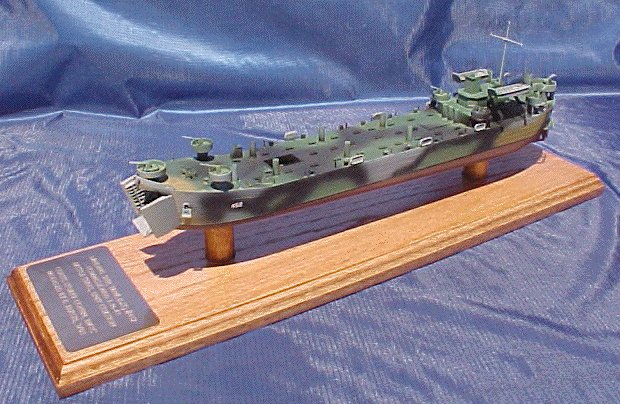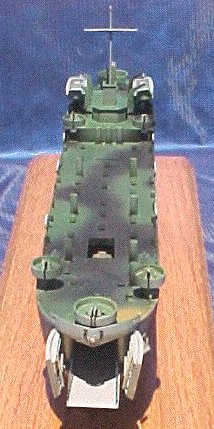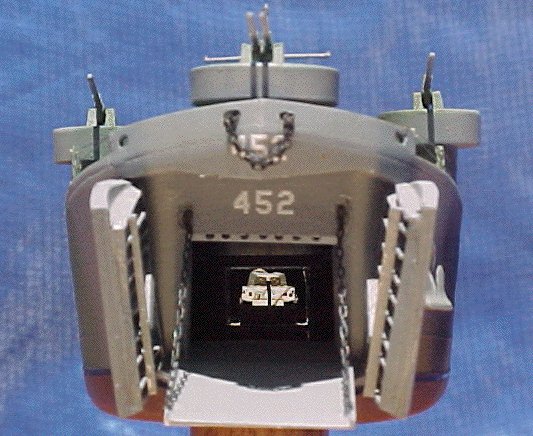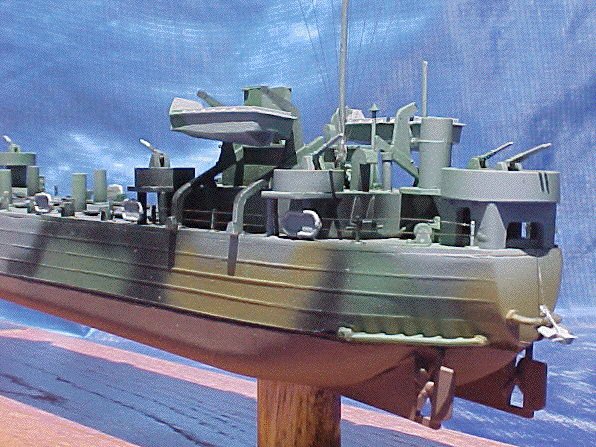
Lindberg 1/245 LST
|
KIT # |
70876 |
|
PRICE: |
$16.98 MSRP |
|
DECALS: |
One ship |
|
REVIEWER: |
|
|
NOTES: |
An oldie but goodie. |

|
HISTORY |
 The LST, or Landing Ship Tank, was
originally developed in World War II as a way of transporting tanks and
trucks from the US to the beaches of Europe. By the end of the war the
LST would find it's way into every theater of the war serving as troop
and vehicle transports, repair and supply ships, and even launching
aircraft! Known to it's crews as the Large Slow Target, the LSTs were
328 feet long and sailed at only 9 knots! LST's were built by shipyards
across the US, including many that were sailed down the Ohio and
Mississippi Rivers to the sea!
The LST, or Landing Ship Tank, was
originally developed in World War II as a way of transporting tanks and
trucks from the US to the beaches of Europe. By the end of the war the
LST would find it's way into every theater of the war serving as troop
and vehicle transports, repair and supply ships, and even launching
aircraft! Known to it's crews as the Large Slow Target, the LSTs were
328 feet long and sailed at only 9 knots! LST's were built by shipyards
across the US, including many that were sailed down the Ohio and
Mississippi Rivers to the sea!The LST was designed to run up onto the beach and then pull itself off by winching in an anchor dropped off the stern. It could hold tanks and trucks both inside and up on deck. Ships #1 - 512 used an electric elevator to access the deck, later ships used a ramp. There was also a cargo hatch in the deck forward of the aft superstructure for additional access below. LST's were equipped with two or more LCVP's hung from davits on deck to aid in landing troops. They were designed to carry a 114' LCT on deck, which was slipped off by tipping the LST to one side! Today the USS LST Memorial, located in Mobile, Alabama, has a fully restored LST and museum.
|
THE KIT |
The kit is based upon a late model LST, with a ramp to the lower deck. It is in 1/245 scale, not a typical size! The hull is 15-1/2" long and cast as one piece. The hull casting was straight and square. The bow doors are NOT open. The deck is made up of two pieces which fit the sides well, but needed a bit of filing where they came together. The superstructure is pretty plain, without any port or hatch detail. Each LST seems to have had a different mix of armament- the kit provides a typical assortment of the larger calibers. The two LCVPs have a reasonable amount of detail. There were a fair number of ejector pins on the model, but they were small and easy to plane off. The kit comes with decals for one ship, #762 (it served in both WWII and Korea).
|
CONSTRUCTION |
 I wanted to model a specific ship, #452,
that my late uncle served on. The kit had to be modified a bit to
backdate it to the earlier design. Construction started with cleaning
off the small amounts of flash and planing down the ejector pin marks
with a chisel. I wanted to have the bow doors open and thus cut then
out along the molded lines with an Xacto knife. Detail was added using
styrene card following pictures found on the web and in the Squadron
book (see below). I then constructed the tank deck in the hold out of
styrene and added a few deck beams near the bow and roughed in the
bulkhead inside the bow opening. A ramp was also scratchbuilt out of
styrene.
I wanted to model a specific ship, #452,
that my late uncle served on. The kit had to be modified a bit to
backdate it to the earlier design. Construction started with cleaning
off the small amounts of flash and planing down the ejector pin marks
with a chisel. I wanted to have the bow doors open and thus cut then
out along the molded lines with an Xacto knife. Detail was added using
styrene card following pictures found on the web and in the Squadron
book (see below). I then constructed the tank deck in the hold out of
styrene and added a few deck beams near the bow and roughed in the
bulkhead inside the bow opening. A ramp was also scratchbuilt out of
styrene.
The deck was modified by cutting an opening for the hoist where the kit's deck ramp would go and lining the opening with some more light styrene. The electric elevator was made from some styrene bars and flat stock. Kinda guessed here - from photos and some oral histories I read on the web it appears that they used columns in each corner of the platform similar to an electric automobile hoist. (Not real visible on the finished model) The motors of the hoists regularly burned out, which may be why the design was changed to a ramp! I also made a cover from scribed styrene for the aft deck hatch as this detail is missing on the kit. The bow bulwarks were drilled out. The superstructure glues up as a series of stacked boxes. I chose not to try to add scribed detail as I could not find any useful photos.. The open bridge seems to be out of scale, as do the steps and handrail stanchions, but the visual effect is ok.
|
CAMOUFLAGE & MARKINGS |
 I temporarily held the doors closed
with Bluetak and airbrushed the hull with acrylics: Model Master
Neutral Gray and Flat Black; Model Shipways Ocean Green 5-OG, Navy
Green 5-NG, Brown 4-A in Measure 31/18L#2 using a plan from
FloatingDrydock.com for LST's in the Pacific in 1944-5. After freehand
airbrushing the camouflage pattern, I masked and painted the bottom
Humbrol 113 - a good reddish brown and then remasked a bootstripe in
Flat Black.
I temporarily held the doors closed
with Bluetak and airbrushed the hull with acrylics: Model Master
Neutral Gray and Flat Black; Model Shipways Ocean Green 5-OG, Navy
Green 5-NG, Brown 4-A in Measure 31/18L#2 using a plan from
FloatingDrydock.com for LST's in the Pacific in 1944-5. After freehand
airbrushing the camouflage pattern, I masked and painted the bottom
Humbrol 113 - a good reddish brown and then remasked a bootstripe in
Flat Black.
|
FINAL CONSTRUCTION |
Final details were added: handrails, flag halyards, aft anchor cable with Invisible Thread , gluing on the bow doors and ram w/chains from Squadron. I pieced together decal numbers from an old set I had. The font, size and style seem to have varied a lot from one ship to another! I was fortunate to find several good photos! The tank on the elevator is made by GHQ Miniatures, in 1/285 scale.
The base is a piece of oak with routed edges, stained and varnished with _" dowels let into the base and glued to the model.
|
CONCLUSIONS |
This was my first ship model in about 40 years! It went together easily enough, plus offered some interesting opportunities for a bit of scratchbuilding; The weird scale is a bit frustrating as the model would look great with the decks crowded with vehicles, but the 1/285 vehicles look too small on deck.
|
REFERENCES |
Adcock, Al, WWII US Landing Craft in Action, Carrollton, Texas,
Squadron /Signal Publications
The Ship Camouflage Web Page,
http://www.shipcamouflage.com/
Source of camo schemes
NavSource Online,
http://www.navsource.org/archives/10/16idx.htm Source of
history of each LST and photos
The Floating Drydock,
http://www.floatingdrydock.com/ Source of camo schemes,
naval paints
Ships of the US Navy, 1940-45, Landing Ships,
http://www.ibiblio.org/hyperwar/USN/ships/ships-ls.html
Ship histories
The USS LST Memorial,
http://www.lstmemorial.org Lots of info, photos and links
June 2003
Copyright ModelingMadness.com
If you would like your product reviewed fairly and fairly quickly, please
contact
the editor or see other details in the Note to
Contributors.